Vercors
Sous-titre
20 February 1942: publication of the novel Le Silence de la Mer
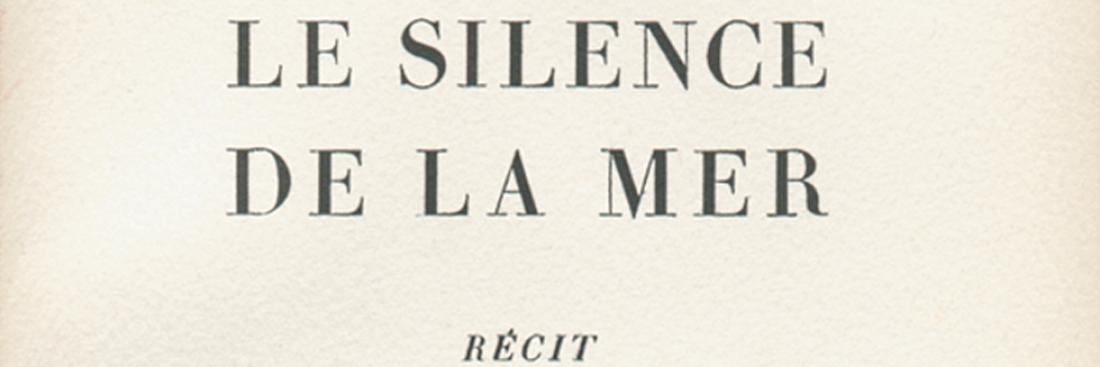
When the Nazis came to power, they immediately began destroying all books and writings deemed contrary to their ideology. The most spectacular expression of this “policy” was the organisation of book burnings, at which large numbers of works were publicly destroyed.
Background
In France, after the armistice of 22 June 1940 and the occupation of part of the country by German troops, a whole system of control and censorship of speech and writing was put in place. In response, pamphlets and newspapers began to be published and distributed in secret. On 28 September 1940, an agreement on the censorship of books in the occupied zone was signed between the Confederation of French Publishers and the German authorities, at the same time as the first “Otto List”, of works banned from distribution, entered circulation. Writers had either to conform or keep quiet.

Jean Bruller, known as “Vercors”, c.1950. Source: Association SEMER / Cercle artistique de Villiers-sur-Morin
Jean Bruller was not a writer as yet. Born on 26 February 1902, he did his secondary education at the École Alsacienne, then qualified as an electrical engineer before embarking on a career as a satirical artist. In 1926, he published his first collection of sketches, Vingt-et-une recettes de mort violente, which was followed by Un homme coupé en tranches, L’Enfer, Visions intimes et rassurantes de la guerre, Silences, and La danse des vivants. In 1929, he began a parallel career as a reviewer of art books.

Source: Association SEMER / Cercle artistique de Villiers-sur-Morin
Mobilised in the Alpine Infantry in 1939, he was wounded in the leg and spent his convalescence at Romans-sur-Isère, in the foothills of the Vercors massif, hence the nom de guerre he would adopt when he joined the Resistance. Demobbed in August 1940, he returned home to Villiers-sur-Morin and became a joiner.
Dismayed by the press siding with the Vichy Government and by the attitude of some writers, who bowed to its wishes, he looked for a way to carry on the fight. Initially, he joined Pierre de Lescure, who was an agent for MI6, to work on setting up a network of intelligence and escape lines for British agents and airmen. Following a betrayal, they were forced to suspend their activity. With Lescure, Bruller wrote articles for publication in the underground communist magazine La Pensée Libre, which was open to writers of all political persuasions. Lescure, who had written a novel, encouraged Bruller to write one too.
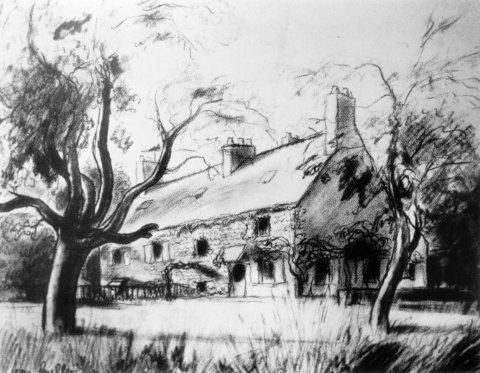
The house from Le Silence de la Mer, in Villiers-sur-Morin, drawing by Jean Bruller. Source: Association SEMER / Cercle artistique de Villiers-sur-Morin
He was deeply troubled by the daily humiliations and repressive German policies, and saw literature as the best way to get involved in the struggle. With it, he hoped to counteract the pervasive official message of collaboration. The novel centres on the figure of a German officer, Werner von Ebrennac, a likeable, cultured Francophile billeted in a French household. Over many months, he tries to persuade his hosts of Germany’s noble intentions, until the day he realises that he himself has been deceived and that he has misled them. Written in the summer of 1941, Le Silence de la Mer (first published in English as Put Out the Light, later as The Silence of the Sea) appeals to the reader to open their eyes to the occupier’s true intentions and not to be taken in by their seductive manoeuvres, however attractive they may appear.
Bruller delivered his manuscript to Lescure in October, but the press that printed La Pensée Libre was discovered by the Germans. Having published his own collections of sketches before the war, he decided to publish the text in book form, and to set up their own underground publishing house. Bruller took care of the technical side of publishing and distribution, while Lescure sought out manuscripts. Through the printer Ernest Aulard, Bruller discovered a small press on Boulevard de l’Hôpital, Paris, belonging to Georges Oudeville, which specialised in notices and business cards. He envisaged a small-format book of about a hundred pages, with a refined finish. Aulard supplied the paper and type. The press – a treadle-operated “Minerva” – could print only eight pages at a time, so it took nearly three months to complete. Every week, Bruller brought in eight pages of the manuscript, which were destroyed as the composition progressed, and left with the printed pages. To begin with, these were delivered to the offices on Boulevard Raspail where a friend of Lescure worked, but after the premises were searched by the Germans, they switched to a café on Boulevard de la Gare. The printing was finished at the end of January. Yvonne Paraf, a friend of Bruller, took care of the binding. In his dealings with the printer and his other contacts, Bruller used the name “Drieu”, and gave the address of the writer Drieu La Rochelle, editor of the Nouvelle Revue Française and a friend of the German Ambassador to France, Otto Abetz.
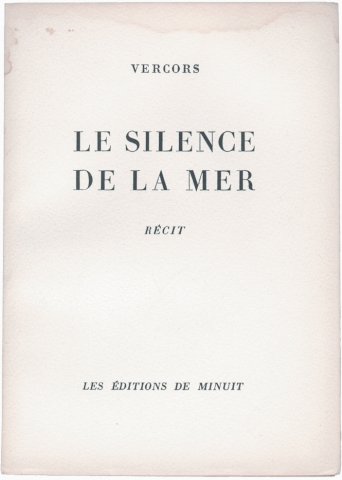
First public edition of Le Silence de la Mer, published by Les Éditions de Minuit - © Les Éditions de Minuit
He signed his tale with the pseudonym “Vercors”, and the new publishing house was given the name “Les Éditions de Minuit”. Three hundred and fifty copies of the book were printed, which were ready by 20 February 1942. The result was a high-quality book, impeccably printed. As Bruller said himself, he had done “a fine job”. Lescure wrote a general foreword denouncing the impact of censorship on the publishing sector, which was a veritable manifesto for writers’ freedom of expression. A chain was formed to distribute the work. Through Jacques Debû-Bridel, who worked at the naval ministry, Lescure contacted Jean Paulhan, senior editor at Éditions Gallimard, and sent him a copy. But threats forced Lescure into hiding. The underground radio station that was supposed to inform London about the publication of the book was shut down, so it was decided to postpone its distribution. Meanwhile, Paulhan passed on his copy to Professor Robert Debré, who had a number of copies made, which meant that the book was already in circulation and Les Éditions de Minuit had already acquired a certain renown even before the “official” launch in November. The name of its author would not be revealed until liberation. To begin with, copies were distributed by a handful of volunteers, then by networks. Initially distributed in the free zone, on 25 July 1943 the book was reprinted for the occupied zone. Entering circulation abroad, it was distributed throughout the world: London – from where it was even parachuted into France – Switzerland, Africa, the United States, Australia.
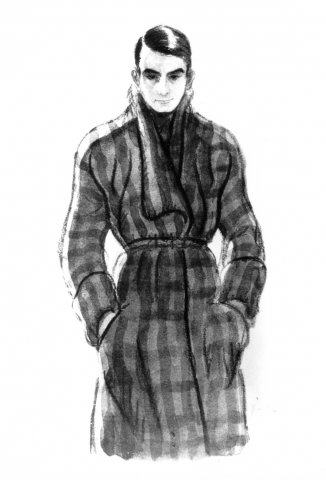
Self-portrait. © Rights reserved
Bruller-Vercors used such discretion and kept so strictly to security measures – not even his wife knew he was the author of Le Silence de la Mer – that he was able to carry on his activities throughout the occupation. In that time, over 20 books were published by Les Éditions de Minuit and distributed in secret. Under a variety of pseudonyms, they included texts by Jacques Maritain, François Mauriac, Louis Aragon, Elsa Triolet, Julien Benda and Jacques Debû-Bridel, as well as Vercors’s second novel, La Marche à l’Étoile (Guiding Star).
If Le Silence de la Mer served as a wake-up call for the occupied French, it has also had a profound impact on generations of young people since the war.
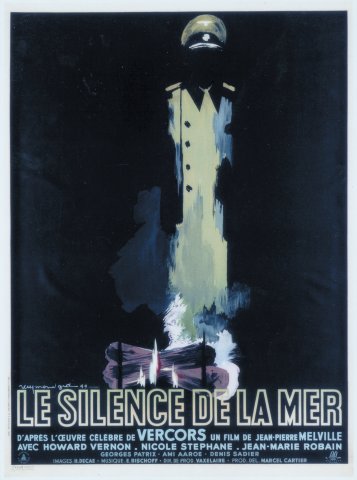
Poster of the 1947 film Le Silence de la Mer, by Raymond Gid - © Adagp, Paris, 2001
In 1947, Le Silence de la Mer was made into a film by Jean-Pierre Melville. Bruller left Les Éditions de Minuit in 1948 and pursued his career as a writer, publishing novels, plays and essays, including: Plus ou moins homme, Les Animaux dénaturés, Zoo ou l’assassin philanthrope, La Bataille du silence, Questions sur la vie à Messieurs les biologistes, Ce que je crois and Moi, Aristide Briand. He died on 10 June 1991.
Insert
General foreword for Les Éditions de Minuit by Pierre de Lescure, inserted in the first edition of Le Silence de la Mer.
In another age, people were exiled for preferring Euripides’s Phaedra to that of Racine. The tyrant of the time sought the glory of France. Today, they ban the physics of Einstein, the psychology of Freud and the songs of Isaiah. We are not allowed to reprint Meredith, Thomas Hardy, Katherine Mansfield, Virginia Woolf, Henry James, Faulkner and all our other beloved authors. “Shakespeare, Milton, Shelley, the English poets and novelists of all eras, are no longer to be displayed in your windows,” dictates the Association of Booksellers, by order of German propaganda. As for French literature, it is “restricted” upon entry into Belgium, Holland, Greece, throughout the New Europe. In September 1940, the Confederation of Publishers signed “a censorship agreement with the occupying authorities”. A warning to the public stated: “By signing this agreement, the German authorities wished to show their confidence in the publishing sector. Publishers, meanwhile, were keen to give French thought the power to continue its mission, while respecting the rights of the victor”, and “the German authorities noted with satisfaction the initiative of the publishers”.
In another era of French history, prefects “invalidated” writers who refused to write in praise of their master. The master would say of the others: “I opened my antechambers to them and they rushed in.”
There are still writers in France who do not know the antechambers and reject the slogans. They feel strongly that thought must be expressed. To act on other thoughts, certainly, but above all because, if it is not expressed, the spirit dies.
That is the goal of Les Éditions de Minuit. Propaganda is not our domain. We mean to preserve our inner lives and to freely serve our art. Names are of little importance. It is no longer a question of personal reputations. It may be a difficult path, but no matter. It is a question of man’s spiritual purity.
Key dates:
22 June 1940: Franco-German armistice signed at Rethondes.
2 July 1940: The French government is installed in Vichy.
10 July 1940: The French parliament grants full powers to Marshal Pétain (569 votes against 80).
11 July 1940: Promulgation of the French State by Marshal Pétain.
12 July 1940: Beginning of the Pétain-Laval cabinet.
16 August 1940: Vichy law establishing Organising Committees for each economic sector.
28 September 1940: Agreement on the censorship of books between the Confederation of French Publishers and the Propaganda-Staffel. First “Otto List”, of works withdrawn from sale by publishers or banned by the German authorities.
24 October 1940: Pétain and Hitler meet at Montoire.
30 October 1940: Speech by Marshal Pétain announcing to the French people that he has chosen the path of collaboration.
3 May 1941: Decree establishing an Organising Committee for the publishing industry, responsible for economic and technical issues relating to the sector.
9 June 1941: Decree establishing a French Book Council concerned with “the intellectual orientation to be given to the production of books, the development of public reading and the distribution of French books”.
20 February 1942: Publication of the novel Le Silence de la Mer.
8 July 1942: Second edition of the Otto list entitled “Undesirable French literary works”.
November 1942: “Official” distribution of Le Silence de la Mer.
10 May 1943: Third edition of the Otto list, of “Undesirable French literary works”.
25 August 1944: Liberation of Paris.
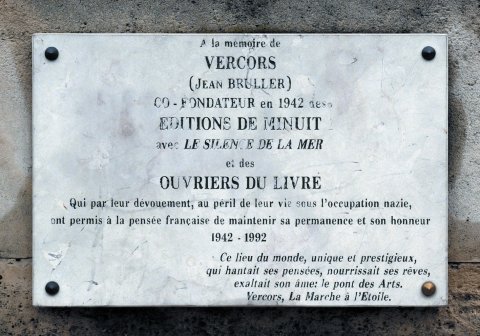
A commemorative plaque is laid on the Pont des Arts, in Paris, where Vercors would meet with Jacques Lecompte-Boinet, leader of the Ceux de la Résistance movement, to give him copies of Les Éditions de Minuit books to deliver to General de Gaulle. Source: MINDEF/SGA/DMPA

